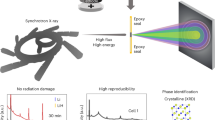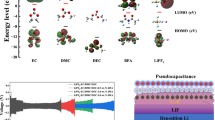Abstract
In any electrochemical device, the interface between electrolyte and electrode should be the only “legitimate” location where redox reactions happen. Particularly in Li ion batteries, these interfaces become “interphases” due to the reactivity of the electrode materials used, and they mainly consist of chemical species from the sacrificial decomposition of electrolyte components. Since the emergence of Li ion technology, it has been recognized that interphase on graphitic anodes, usually referred as SEI (solid electrolyte interphase) after its electrolyte attributes, is the key component supporting the reversibility of Li+-intercalation chemistry. Research attention focused on this component during the past two decades has led to substantial understanding about both its chemistry and mechanism. This article summarizes these progresses, and elaborates on the relatively recent insights, including the effect of Li+-solvation sheath structure on the interphasial processes at graphitic anode. A new strategy of forming a more desirable interphase is also discussed.











Similar content being viewed by others
References
J.B. Goodenough and Y. Kim: Challenges for rechargeable Li batteries. Chem. Mater. 22, 587 (2010).
K. Xu: Nonaqueous liquid electrolytes for lithium-based rechargeable batteries. Chem. Rev. 104, 4303 (2004).
E. Peled and H. Straze: The kinetics of the magnesium electrode in thionyl chloride solutions. J. Electrochem. Soc. 124, 1030 (1977).
E. Peled: The electrochemical behavior of alkali and alkaline earth metals in nonaqueous battery systems—the solid electrolyte interphase model. J. Electrochem. Soc. 126, 2047 (1979).
Y. Wang and P. Balbuena, eds: Lithium Ion Batteries: Solid Electrolyte Interphase (Imperial College Press, London2004).
M.G.S.R Thomas, P.G. Bruce, and J.B. Goodenough: AC impedance analysis of polycrystalline insertion electrodes: Application to Li1-xCoO2. J. Electrochem. Soc. 132, 1521 (1985).
L. Yang, B. Ravdel, and B. Lucht: Electrolyte reactions with the surface of high voltage Li Ni0.5Mn1.5O4 cathodes for lithium ion batteries. Electrochem. Solid-State Lett. 13, A95 (2010).
A.V. Cresce and K. Xu: Electrolyte additive in support of 5V Li ion chemistry. J. Electrochem. Soc. 158, A337 (2011).
K. Xu: Whether EC and PC differ in interphasial chemistry on graphitic anodes and how. J. Electrochem. Soc. 156, A751 (2009).
A. Hérold: Research on the graphite intercalation compounds. Bull. Soc. Chim. Fr. 187, 999 (1955).
A.N. Dey and B.P. Sullivan: The electrochemical decomposition of propylene carbonate on graphite. J. Electrochem. Soc. 117, 222 (1970).
R. Yazami and P.H. Touzain: A reversible graphite-lithium negative electrode for electrochemical generators. J. Power Sources 9, 365 (1983).
T. Nagaura: Li ion batteries. In Proceedings of the 5th International Seminar on lithium battery technology and applications, Deerfield Beach, FL. March 5-7, 1990. Florida Educational Seminars Inc., Boca Raton, FL, 1990.
R. Fong, U. von Sacken, and J.R. Dahn: Studies of lithium intercalation into carbons using nonaqueous electrochemical cells. J. Electrochem. Soc. 137, 2009 (1990).
D. Aurbach, M.L. Daroux, P.W. Faguy, and E. Yeager: Identification of surface films formed on lithium in propylene carbonate solutions. J. Electrochem. Soc. 134, 1611 (1987).
D. Aurbach, Y. Gofer, and M. Ben-Zion: Solutions of LiAsF6 in 1,3-dioxolane for secondary lithium batteries. J. Power Sources 39, 163 (1992).
D. Aurbach, B. Markovsky, A. Schecter, Y. Ein-Eli, and H. Cohen: A comparative study of synthetic graphite and Li electrodes in electrolyte solutions based on ethylene carbonate-dimethyl carbonate mixtures. J. Electrochem. Soc. 143, 3809 (1996).
K. Xu, U. Lee, S. Zhang, and T.R. Jow: Synthesis and characterization of lithium alkyl mono- and dicarbonates as components of surface films in Li-ion batteries. J. Phys. Chem. B. 110, 7708 (2006).
K. Kanamura, H. Tamura, S. Shiraishi, and Z. Takehara: XPS analysis of lithium surfaces following immersions in various solvents containing LiBF4. J. Electrochem. Soc. 142, 340 (1995).
E. Peled, D. Golodnitsky, C. Menachem, D. Bar-Tow: An advanced tool for the selection of electrolyte components for rechargeable lithium batteries. J. Electrochem. Soc. 145, 3482 (1998).
G.V. Zhuang, K. Xu, H. Yang, T.R. Jow, and P.N. Ross Jr: Lithium ethylene dicarbonate identified as the primary product of chemical and electrochemical reduction of EC in 1.2M LiPF6/EC: EMC electrolyte. J. Phys. Chem. B 109, 17567 (2005).
S. Malmgren, H. Rensmo, T. Gustafsson, M. Gorgoi, and K. Edström: Nondestructive depth profiling of the solid electrolyte interphase on LiFePO4 and graphite electrodes. ECS Trans. 25, 121 (2010).
G.V. Zhuang and P.N. Ross: Analysis of the chemical composition of the passive film on Li-ion battery anodes using attenuated total reflection infrared spectroscopy. Electrochem. Solid-State Lett. 6, A136 (2006).
M. Onuki, S. Kinoshita, Y. Sakata, M. Yanagidate, Y. Otake, and M. Ue: Identification of the source of evolved gas in Li-ion batteries using 13C-labeled solvents. J. Electrochem. Soc. 155, A794 (2008).
K. Xu, S. Zhang, B.A. Bruce, and T.R. Jow: Lithium bis(oxalate)borate stabilizes graphite anode in propylene carbonate. Electrochem. Solid-State Lett. 5, A259 (2002).
S.K. Jeong, M. Inaba, Y. Iriyama, T. Abe, and Z. Ogumi: Electrochemical intercalation of lithium ion within graphite from propylene carbonate solutions. Electrochem. Solid-State Lett. 6, A13 (2003).
A. Xiao, L. Yang, B.L. Lucht, S.H. Kang, and D.P. Abraham: Examining the solid electrolyte interphase on binder-free graphite electrodes. J. Electrochem. Soc. 156, A318 (2009).
A.C. Chu, J.Y. Josefowicz, and G.C. Farrington: Electrochemistry of highly ordered pyrolytic graphite surface film formation observed by atomic force microscopy. J. Electrochem. Soc. 144, 4161 (1997).
K.A. Hirasawa, T. Sato, H. Asahina, S. Yamaguchi, and S. Mori: In situ electrochemical atomic force microscope study on graphite electrodes. J. Electrochem. Soc. 144, L81 (1997).
R. Imhof and P. Novák: In situ investigation of the electrochemical reduction of carbonate electrolyte solutions at graphite electrodes. J. Electrochem. Soc. 145, 1081 (1998).
D. Bar-Tow, E. Peled, and L. Burstein: A study of highly oriented pyrolytic graphite as a model for the graphite anode in Li-ion batteries. J. Electrochem. Soc. 146, 824 (1999).
K. Persson, V.A. Sethuraman, L.J. Hardwick, Y. Hinuma, Y.S. Meng, A.V.D Ven, V. Srinivasan, R. Kostecki, and G. Ceder: Lithium diffusion in graphitic carbon. J. Phys. Chem. Lett. 1, 1176 (2010).
S.S. Zhang: A review on electrolyte additives for lithium-ion batteries. J. Power Sources 162, 1379 (2006).
C. Jehoulet, P. Biensan, J.M. Bodet, M. Broussely, C. Moteau, and C. Tessier-Lescourret: in Batteries for Portable Applications and Electric Vehicles. C.F. Holmes, A.R. Landgrebe, eds., The Electrochemical Society Proceeding Series, Pennington, NJ, 1997; pp. 97–18, P974.
D. Aurbach, K. Gamolsky, B. Markovsky, Y. Gofer, M. Schmidt, and U. Heider: On the use of vinylene carbonate (VC) as an additive to electrolyte solutions for Li-ion batteries. Electrochim. Acta 47, 1423 (2002).
J.O. Besenhard and H.P. Fritz: Cathodic reduction of graphite in organic solutions of alkali and NR4+ salts. J. Electroanal. Chem. 53, 329 (1974).
J.O. Besenhard, M. Winter, J. Yang, and W. Biberacher: Filming mechanism of lithium-carbon anodes in organic and inorganic electrolytes. J. Power Sources 54, 228 (1995).
M.R. Wagner, J.H. Albering, K.C. Moeller, J.O. Besenhard, and M. Winter: XRD evidence for the electrochemical formation of Li+(PC)yC-n. Electrochem. Commun 7, 947 (2005).
Y. Mizutani, T. Abe, K. Ikeda, E. Ihara, M. Asano, T. Harada, M. Inaba, and Z. Ogumi: Graphite intercalation compounds prepared in solutions of alkali metals in 2-methyltetrahydrofuran and 2, 5-dimethyltetrahydrofuran. Carbon 35, 61 (1997).
T. Abe, N. Kawabata, Y. Mizutani, M. Inaba, and Z. Ogumi: Correlation between cointercalation of solvents and electrochemical intercalation of lithium into graphite in propylene carbonate solution. J. Electrochem. Soc. 150, A257 (2003).
K. Xu: “Charge-transfer” process at graphite/electrolyte interface and the solvation sheath structure of Li+ in nonaqueous electrolytes. J. Electrochem. Soc. 154, A162 (2007).
K. Xu, Y. Lam, S.S. Zhang, T.R. Jow, and T.B. Curtis: Solvation sheath of Li+ in nonaqueous electrolytes and its implication of graphite/electrolyte interface chemistry. J. Phys. Chem. C 111, 7411 (2007).
E. Peled, D. Bar Tow, A. Merson, A. Gladkich, L. Burstein, and D. Golodnitsky: Composition, depth profiles and lateral distribution of materials in the SEI built on HOPG-TOF SIMS and XPS studies. J. Power Sources 97/98, 52 (2001).
D. Alliata: Electrochemical SPM investigation of the solid electrolyte interphase film formed on HOPG electrodes. Electrochem. Commun. 2, 436 (2000).
F.P. Campana, R. Kötz, J. Vetter, P. Novák, and H. Siegenthaler: In situ atomic force microscopy study of dimensional changes during Li+ ion intercalation/deintercalation in highly oriented pyrolytic graphite. Electrochem. Commun. 7, 107 (2005).
H. Zhang, F. Li, C. Liu, J. Tan, and H. Cheng: New insights into the solid electrolyte interphase with use of a focused ion beam. J. Phys. Chem. B 109, 22205 (2005).
E. Peled, D. Golodnitsky, A. Ulus, and V. Yufit: Effect of carbon substrate on SEI composition and morphology. Electrochim. Acta 50, 391 (2004).
P. Lu and S.J. Harris: Lithium transport within the solid electrolyte interphase. Electrochem. Commun. 13, 1035 (2011).
A.J. Smith, J.C. Burns, S. Trussler, and J.R. Dahn: Precision measurements of the coulombic efficiency of lithium–ion batteries and of electrode materials for lithium-ion batteries. J. Electrochem. Soc. 157, A196 (2010).
A.J. Smith, J.C. Burns, and J.R. Dahn: A high precision study of the Coulombic efficiency of Li-ion batteries. Electrochem. Solid State Lett. 13, A177 (2010).
J.C. Burns, G. Jain, A.J. Smith, K.W. Eberman, E. Scott, J.P. Gardner, and J.R. Dahn: Evaluation of effects of additives in wound Li-ion cells through high precision Coulometry. J. Electrochem. Soc. 158, A255 (2011).
A.J. Smith, J.C. Burns, X. Zhao, D. Xiong, and J.R. Dahn: A high precision coulometry study of the SEI growth in Li/graphite cells. J. Electrochem. Soc. 158, A447 (2011).
M. Tang and J. Newman: Electrochemical characterization of SEI-type passivating films using redox shuttles. J. Electrochem. Soc. 158, A530 (2011).
Y.M. Chiang, W.C. Carter, B.H. Ho, and M. Duduta: High energy density redox flow device. U.S. Patent No. 2010/0047671 A1. (Published on Feb. 25, 2010).
M. Duduta, B. Ho, V.C. Wood, P. Limthongkul, V.E. Brunini, W.C. Carter, and Y.M. Chiang: Semisolid lithium rechargeable flow battery. Adv. Eng. Mater. 1, 511 (2011).
S.K. Jeong, M. Inaba, Y. Iriyama, T. Abe, and Z. Ogumi: Surface film formation on a graphite negative electrode in lithium-ion batteries: AFM study on the effects of cosolvents in ethylene carbonate-based solutions. Electrochim. Acta. 47, 1975 (2002).
S. Yanase and T. Oi: Solvation of lithium ion in organic electrolyte solutions and its isotopic reduced partition function ratios studied by ab initio molecular orbital method. J. Nucl. Sci. Technol. 39, 1060 (2002).
T. Fukushima, Y. Matsuda, H. Hashimoto, and R. Arakawa: Studies on solvation of lithium ions in organic electrolyte solutions by electrospray ionization-mass spectrometry. Electrochem. Solid-State Lett. 4, A127 (2001).
Y. Matsuda, T. Fukushima, H. Hashimoto, and R. Arakawa: Solvation of lithium ions in mixed organic electrolyte solutions by electrospray ionization mass spectrometry. J. Electrochem. Soc. 149, A1045 (2002).
M. Morita, Y. Asai, N. Yoshimoto, and M. Ishikawa: A Raman spectroscopic study of organic electrolyte solutions based on binary solvent systems of ethylene carbonate with low viscosity solvents which dissolve different lithium salts. J. Chem. Soc. Faraday Trans. 94, 3451 (1998).
O. Borodin and G. Smith: Quantum chemistry and molecular dynamics simulation study of dimethyl carbonate: Ethylene carbonate electrolytes doped with LiPF6. J. Phys. Chem. B 113, 1763 (2009).
L. Yang, A. Xiao, and B. Lucht: Investigation of solvation in lithium ion battery electrolytes by NMR spectroscopy. J. Mol. Liq. 154, 131 (2010).
A.V. Cresce and K. Xu: Preferential solvation of Li+ directs formation of interphase on graphitic anode. Electrochem. Solid-State Lett. 14, A154 (2011).
Y. Yamada, Y. Iriyama, T. Abe, and Z. Ogumi: Kinetics of lithium ion transfer at the interface between graphite and liquid electrolytes: Effects of solvent and surface film. Langmuir 25, 12766 (2009).
K. Xu, A.V. Cresce, and U. Lee: Differentiating contributions to “ion transfer” barrier from interphasial resistance and Li+-desolvation at electrolyte/graphite interface. Langmuir 26, 11538 (2010).
Author information
Authors and Affiliations
Corresponding author
Additional information
This paper has been selected as an Invited Feature Paper.
Rights and permissions
About this article
Cite this article
Xu, K., von Wald Cresce, A. Li+-solvation/desolvation dictates interphasial processes on graphitic anode in Li ion cells. Journal of Materials Research 27, 2327–2341 (2012). https://doi.org/10.1557/jmr.2012.104
Received:
Accepted:
Published:
Issue Date:
DOI: https://doi.org/10.1557/jmr.2012.104




